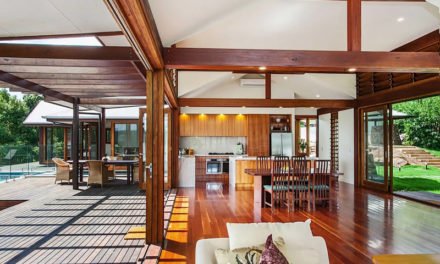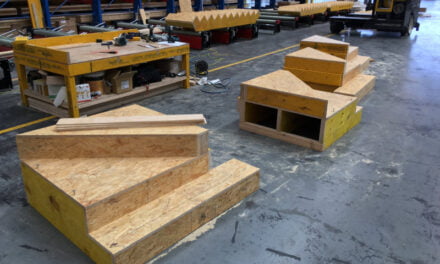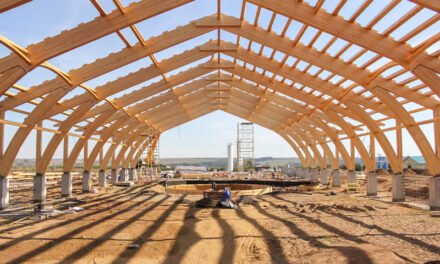
Timber lining boards deliver timeless beauty to both commercial and residential builds, in addition to a host of practical and environmental benefits. By Donyale Harrison
Jacob Ferrow is telling me about his customers. “They understand that we source our timbers from sustainable forestry and that by choosing timber they get additional boxes ticked, ranging from natural insulation to health benefits,” says the general manager of Timbeck, a Queensland- based timber specialist.
“But when it comes down to it, most of them are making decisions based on looks.”
Timber lining boards hold a special place in interior decoration. While there are trends in profiles and coating options or how they’re installed, the choice of timber in homes, offices, schools and commercial spaces is driven by the material’s timelessness. The one wall or feature can simultaneously hark back to age-old traditions, evoke crisp Mid-Century Modern and be utterly up to date.
I spoke with Ferrow and also the team at Porta about their ranges and how they can elevate your build. Both Timbeck and Porta are multi-generational family businesses with long histories in decorative timbers. Their lining board offers differ somewhat in focus, but both companies were happy to share key insights based on their expertise.
SOUNDING OUT NEEDS
“My grandfather started Timbeck stocking mostly Oregon framework,” says Ferrow. “In the ’90s, we shifted our focus into western red cedar and a lot of that was run as slats for venetian blinds and plantation shutters.
“As a result, we have a lot of specialised equipment and highly trained machinists in the company.”
As western red cedar costs rose over the past 15 or so years, Timbeck looked to the local hardwoods that were on offer from their certified sustainable partners. Ferrow says, “We had access to Queensland spotted gum and blackbutt, and these are really beautiful timbers that were ideal for a different range of products, so we moved into screening and panelling products, as well as cladding.”
The new products found a ready market. “The hardwood is used all the way down the east coast in residential settings, particularly at the high end, because of how hard wearing and durable it is,” says Ferrow. “It’s a lovely product that ticks all the boxes on different colours and natural character and, importantly, meets a lot of the standards required in terms of durability as well as having a BAL 29 bushfire rating for the spotted gum and blackbutt.”
Happily, they also found a ready market in commercial applications, where practical considerations play more of a role.
“Yes, looks are important there, too, but specifiers are also choosing timber boards for their impressive insulation. They keep cool air in over the summer and warm air in winter, plus they are much better with acoustics than hard screening surfaces.
“Again, these boards are naturally hard wearing. They’re long lasting, you can sand them back and recoat if you want to change colours. So they’re a very attractive option for those bigger builds.”
In addition to the cedar, spotted gum and blackbutt that Timbeck have on offer, the company also regularly runs Victorian ash, American oak and hemlock.
“This means we’re able to respond well to technical needs,” says Ferrow. “Obviously there are weight issues: particularly if you’re covering a ceiling, where you might use hemlock or cedar, which weigh much less than spotted gum, for example. But we’ve also supplied a lot of samples and then product into businesses who do their own acoustic testing for theatres and the like, where the designer is looking for different settings in the quality of the sound.
“We work quite heavily with a company based in Sydney called Screenwood, which designs its own ceiling and screening systems. They make panels with a range of timber screening sizes that come in alternate lengths for easy install, with an acoustic foam backing, so they can suit the acoustic needs of a space. We provide different species and sizes to get the right results.”
This broad scope of technical options is matched with aesthetic choices. “We moved into the pre-coated side of things a little while ago,” Ferrow says.
“On interior products we’re usually using a lacquer and often that’s just clear, because people love the natural qualities of these timbers. But we can do walnuts, darks, blacks, whitewashes… all different types of things. We use a low-VOC lacquer that goes through a vacuum coater. That means that we can seal the board all around, put it in a pack and at the other end they can literally take it out of the pack and put it on a wall. We’ve already done the sanding and coating. So a fit for purpose product arrives on site ready for use. By sealing the board all round before installation, we are creating the best possible protection for the product to ensure it performs in its intended application long term.”


EASY DOES IT
Porta’s history as a timber supplier is a few decades longer than Timbeck’s, but quite similar. For many years the Melbourne-based business has been delivering decorative timbers Australia-wide. Famous for its Contours range of lining boards, which is a staple in both residential and commercial, the company has recently released Portaline, a primed pine range of lining boards.
“We’ve seen a huge increase in the number of people choosing to DIY,” says Jessica Dinh, digital marketing coordinator at Porta. “Which is what led us to create Portaline, with its exceptionally straightforward installation process.”
The Porta team pays close attention to feedback and data coming in on its products and had noticed an increase in special orders for Contour boards coming from non-trades customers, especially the pre-primed finger- jointed option. The Porta product team designed the Contours range specifically for easy, single-person installation, but despite this, it maintains its status as a professional- grade product.
“Recognising the diverse range of skills and experiences among DIY enthusiasts, we’ve ensured that the Portaline range is accessible to all, regardless of their expertise level,” says the Porta team.
Accordingly, Portaline is a pre-primed, finger-jointed pine board that is lightweight and has a meticulously designed, intuitive and practically foolproof installation process based on easy gluing and, like the Contours range, is simple to install on curves.
“It’s all about speeding up the process for the DIY user,” says Dinh. “The Contours range is exclusively available through special orders, with the majority of customers traditionally relying on tradies for installation. We know that at the moment, trades are booked up weeks or months in advance. With Portaline, it’s available immediately in Bunnings stores and you can prep your surfaces, buy your boards, take them home and install them and then paint them all in the one weekend.
“Even if you’re not an expert DIYer, the installation guide available on our site and on the Bunnings product page will walk you through, step by step.”
The Contours range informed the Porta team’ choices when it came to the Portaline range: while many customers opted for the timeless beauty of natural wood in the Tasmanian oak and engineered American oak boards, the ready-to-stain clear pine and primed FJ pine boards were extremely popular. “These provide a versatile foundation for a bespoke colour selection, catering to those seeking to inject a personal touch into their spaces,” says the Porta team.
It was a similar case when it came to the choice of available profiles. “Trends in profile preferences are largely driven by personal taste, however, we’ve noticed a distinct affinity for certain profiles within our Contours range and so reflected them in the versatile 12mm Portaline,” says the Porta team. “This offers an expanded palette for creative expression, catering to the evolving tastes and preferences of our customers.”
Fans of the Contours Riverine profile will welcome the Portaline Dune, for example, while Strata is echoed in Mesa and the fashionable scalloped profile of Contours Cirque is available in Portaline Peak.
“And because the pine is so light compared to our traditional Tasmanian oak ranges, it’s perfect for ceilings,” says Dinh.

SUSTAINABILITY
For both companies, ensuring consistency and sustainability of supply are core goals. “We’re famous for our Tas oak range,” says Dinh. “But it’s a finite resource, no matter how much we focus on sustainable production and harvest or diversify our supplier base. So that’s another advantage of the Portaline, the pine allows us to keep more of the slower- growing species for applications where it’s more vital. And we have FSC and PEFC certification for all our timbers, with a solid chain of custody process.”
A similar concern has driven Timbeck. “Originally, we were concerned about rising costs for cedar,” says Ferrow. “But when we started moving into local species, we realised the additional advantages when it came to controlling supply and lowering the carbon and monetary costs of the freight.
“Our cedar comes from Canada and while it’s all PEFC certified, that’s then shipped around the world. Our spotted gum and blackbutt come from within an eight-hour drive, often less. Yes, there are different issues that then come up, with it being harder to cut and taking longer to dry, but we’re lucky that we have a large facility and so can hold onto our feedstock for that longer period of time and then we just kiln-dry the last 10% or so for a very stable product.”












